VaNetChain: A Framework for Trustworthy Exchanges of Information in VANETs Based on Blockchain and a Virtualization Layer
Abstract
Featured Application
Abstract
1. Introduction
- First, a virtualization layer sits on top of the TCP/IP protocol stack to have the vehicles emulate a reliable network of static virtual nodes for the communications. In particular, we use the VaNetLayer system [30], which has been shown to improve the performance of VANET communications in simulations of urban scenarios [31].
- Second, blockchain technology is used to enable features of data integrity, traceability, and reliability that cannot be furnished by the consensus and reputation mechanisms that have shown up in the literature of VANETs in recent years. Specifically, we adopt the principles of Ethereum because its widely supported implementation of smart contracts provides suitable means for the definition of a range of service conditions.
2. Related Work
2.1. Routing Protocols in VANETs
2.2. Reliability and Traceability of Data in VANETs
- Some approaches assess the reliability of the vehicles through a reputation system that relies on a centralized entity, which collects the opinions of neighboring nodes [44,45,46,47]. In scenarios of high mobility, these approaches struggle to collect sufficient information to calculate the reputation scores for each node; furthermore, the centralized entity represents a single point of failure.
- Other approaches resort to the cooperation among several sources of information to assess the reliability of the data they receive [48,49,50]. The need to replicate packets onto several nodes increases the communication overhead and the latencies, and in cases of high mobility it is hard to ensure the necessary levels of collaboration.
- The authors of [58] presented a reputation mechanism inspired by Bitcoin, in which unique cryptographic identifiers, known as the Intelligent Vehicle Trust Points (IV-TP), are created and delivered by authorized dealers. The higher the IV-TP achieved by a node, the more trustworthy it is considered.
- An anonymous blockchain-based reputation system was presented in [26], with two blockchains handled in parallel: the first one to store the certificates issued by a certification authority, together with the reputation scores of the corresponding nodes, and the second one to keep track of revoked public keys. When a communication is initiated between vehicles and/or roadside units, the validity of their certificates and public keys is checked by searching in the two blockchains. A similar approach was presented in [59], based on a lightweight blockchain protocol to keep track of all certificates (issued and revoked), whereas the authors of [60] made a proposal to speed up the authentication and revocation processes.
- The authors of [61] proposed a new type of blockchain to address aspects of security and reliability in the dissemination of emergency messages, which are relevant within a certain distance from the location of an incident. In order to validate the disseminated messages, the vehicles use certificates provided by the closest RSU, which guarantees that they were in a location close to the incident they are reporting.
3. VaNetChain: Architecture
- In an INITIAL state, the VN waits for a physical node to initiate a transaction, which takes it to REQUEST state and sets to 0 the counters used thereafter: requestCount and validationCount.
- Within REQUEST, the t_RequestValidators timer is activated and an m_RequestValidators message is sent, incrementing the requestCount by 1. The objective is to request the presence of at least 3 local nodes in the region to pre-validate the transaction. If t_RequestValidators expires without reaching the minimum number of validators, the REQUEST is reactivated once, and if it fails again the VN evolves to CHANGE state. Otherwise, the state becomes VALIDATION.
- The CHANGE state denotes that the region does not have enough vehicles to pre-validate the transaction. In response to that, a neighboring VN is asked to take over by transmitting an m_changeCVN message.
- In VALIDATION state, the VN confirms the participation of the validators and responds with an m_InitValidation message, which activates the t_WaitValidation timer and increases the validationCount. This process is repeated up to 3 times, remaining in VALIDATION until it receives the requested verifications through m_ValidatedTransactions messages. If validationCount rises to 4, it automatically moves to CHANGE, otherwise it can fall into DROP or PROPAGATE.
- The DROP state means that positive validations were not sufficient, so the transaction is discarded. Then, an m_DropTransaction message is broadcast and the state becomes VIRTUAL NODE.
- Having got the minimum number of positive validations, the PROPAGATE state is reached, where the VN sends the validated transaction to the nearest mRSUS accompanied by the message m_confirmMRSU, which activates the t_WaitMRSU timer. While the timer is active, it waits for the confirmation message m_StatusMRSU==true. If this is not received, the process is repeated indefinitely in order to guarantee that the information has reached the mRSU.
4. Simulation Experiments
4.1. Performance of the Communications
- A non-virtualized configuration with a protocol stack like the one on the left hand side of Figure 1, with IGRP as the routing protocol.
- A VaNetChain configuration with a protocol stack like the one on the right hand side of Figure 1, with VNAODV+ as routing protocol (reactive).
- Another VaNetChain configuration with a protocol stack like the one on the right hand side of Figure 1, with VNIBR as routing protocol (geographic, intersection-based).
4.2. Cost of the Transactions
5. Conclusions and Future Work
Author Contributions
Funding
Acknowledgments
Conflicts of Interest
References
- Zhang, D.; Yu, F.R.; Yang, R. Blockchain-Based Distributed Software-Defined Vehicular Networks: A Dueling Deep Q Learning Approach. IEEE Trans. Cogn. Commun. Netw. 2019, 5, 1086–1100. [Google Scholar] [CrossRef]
- Deng, X.; Gao, T. Electronic Payment Schemes Based on Blockchain in VANETs. IEEE Access 2020, 8, 38296–38303. [Google Scholar] [CrossRef]
- Ilarri, S.; Delot, T.; Trillo-Lado, R. A data management perspective on vehicular networks. IEEE Commun. Surv. Tutor. 2015, 17, 2420–2460. [Google Scholar] [CrossRef]
- Kim, S. Impacts of Mobility on Performance of Blockchain in VANET. IEEE Access 2019, 7, 68646–68655. [Google Scholar] [CrossRef]
- Batabyal, A.A.; Beladi, H. The optimal provision of information and communication technologies in smart cities. Technol. Forecast. Soc. Chang. 2019, 147, 216–220. [Google Scholar] [CrossRef]
- Rasheed, A.; Gillani, S.; Ajmal, S.; Qayyum, A. Vehicular ad hoc network (VANET): A survey, challenges, and applications. In Vehicular Ad-Hoc Networks for Smart Cities; Springer: Berlin/Heidelberg, Germany, 2017; pp. 39–51. [Google Scholar]
- Belli, D.; Chessa, S.; Kantarci, B.; Foschini, L. Toward Fog-Based Mobile Crowdsensing Systems: State of the Art and Opportunities. IEEE Commun. Mag. 2019, 57, 78–83. [Google Scholar] [CrossRef]
- Alamer, A.; Deng, Y.; Wei, G.; Lin, X. Collaborative security in vehicular cloud computing: A game theoretic view. IEEE Netw. 2018, 32, 72–77. [Google Scholar] [CrossRef]
- van der Heijden, R.W.; Dietzel, S.; Leinmüller, T.; Kargl, F. Survey on misbehavior detection in cooperative intelligent transportation systems. IEEE Commun. Surv. Tutor. 2018, 21, 779–811. [Google Scholar] [CrossRef]
- Ni, J.; Zhang, A.; Lin, X.; Shen, X.S. Security, privacy, and fairness in fog-based vehicular crowdsensing. IEEE Commun. Mag. 2017, 55, 146–152. [Google Scholar] [CrossRef]
- Kaffash, S.; Nguyen, A.T.; Zhu, J. Big data algorithms and applications in intelligent transportation system: A review and bibliometric analysis. Int. J. Prod. Econ. 2020, 231, 107868. [Google Scholar] [CrossRef]
- Liu, L.; Chen, C.; Qiu, T.; Zhang, M.; Li, S.; Zhou, B. A data dissemination scheme based on clustering and probabilistic broadcasting in VANETs. Veh. Commun. 2018, 13, 78–88. [Google Scholar] [CrossRef]
- Iancu, B.; Illyes, I.; Peculea, A.; Dadarlat, V. Pollution Probes Application: The impact of using PVDM messages in VANET infrastructures for environmental monitoring. In Proceedings of the 2019 IEEE 15th International Conference on Intelligent Computer Communication and Processing (ICCP), Cluj-Napoca, Romania, 5–7 September 2019; pp. 443–449. [Google Scholar]
- Rahman, F.I. Impact of V2V Communication on Eco-Route Choice. LOGI–Sci. J. Transp. Logist. 2020, 11, 37–45. [Google Scholar] [CrossRef]
- Liu, X.; Jaekel, A. Congestion control in V2V safety communication: Problem, analysis, approaches. Electronics 2019, 8, 540. [Google Scholar] [CrossRef]
- Eswaraprasad, R.; Raja, L. Improved intelligent transport system for reliable traffic control management by adapting internet of things. In Proceedings of the 2017 International Conference on Infocom Technologies and Unmanned Systems (Trends and Future Directions)(ICTUS), Dubai, UAE, 18–20 December 2017; pp. 597–601. [Google Scholar]
- Panagiotou, N.; Zygouras, N.; Katakis, I.; Gunopulos, D.; Zacheilas, N.; Boutsis, I.; Kalogeraki, V.; Lynch, S.; O’Brien, B. Intelligent urban data monitoring for smart cities. In Joint European Conference on Machine Learning and Knowledge Discovery in Databases; Springer: Berlin/Heidelberg, Germany, 2016; pp. 177–192. [Google Scholar]
- Bhatia, A.; Haribabu, K.; Gupta, K.; Sahu, A. Realization of flexible and scalable VANETs through SDN and virtualization. In Proceedings of the 2018 International Conference on Information Networking (ICOIN), Chiang Mai, Thailand, 10–12 January 2018; pp. 280–282. [Google Scholar]
- Shrestha, R.; Bajracharya, R.; Nam, S.Y. Challenges of future VANET and cloud-based approaches. Wirel. Commun. Mob. Comput. 2018, 2018, 5603518. [Google Scholar] [CrossRef]
- Bravo-Torres, J.F.; Ordóñez-Morales, E.F.; López-Nores, M.; Blanco-Fernández, Y.; Pazos-Arias, J.J. Virtualization in VANETs to support the vehicular cloud—Experiments with the network as a service model. In Proceedings of the Third International Conference on Future Generation Communication Technologies (FGCT 2014), Luton, UK, 13–15 August 2014; pp. 1–6. [Google Scholar]
- Cui, J.; Wei, L.; Zhong, H.; Zhang, J.; Xu, Y.; Liu, L. Edge Computing in VANETs-An Efficient and Privacy-Preserving Cooperative Downloading Scheme. IEEE J. Sel. Areas Commun. 2020, 38, 1191–1204. [Google Scholar] [CrossRef]
- Guo, J.; Song, B.; Chen, S.; Yu, F.R.; Du, X.; Guizani, M. Context-Aware Object Detection for Vehicular Networks Based on Edge-Cloud Cooperation. IEEE Internet Things J. 2019, 7, 5783–5791. [Google Scholar] [CrossRef]
- Shrestha, R.; Bajracharya, R.; Nam, S.Y. Blockchain-based message dissemination in VANET. In Proceedings of the 2018 IEEE 3rd International Conference on Computing, Communication and Security (ICCCS), Kathmandu, Nepal, 25–27 October 2018; pp. 161–166. [Google Scholar]
- Cunha, F.; Villas, L.; Boukerche, A.; Maia, G.; Viana, A.; Mini, R.A.; Loureiro, A.A. Data communication in VANETs: Protocols, applications and challenges. Ad Hoc Netw. 2016, 44, 90–103. [Google Scholar] [CrossRef]
- Zheng, D.; Jing, C.; Guo, R.; Gao, S.; Wang, L. A traceable blockchain-based access authentication system with privacy preservation in VANETs. IEEE Access 2019, 7, 117716–117726. [Google Scholar] [CrossRef]
- Lu, Z.; Wang, Q.; Qu, G.; Liu, Z. Bars: A blockchain-based anonymous reputation system for trust management in VANETs. In Proceedings of the 17th IEEE International Conference on Trust, Security And Privacy In Computing and Communications/12th IEEE International Conference on Big Data Science and Engineering (TrustCom/BigDataSE), New York, NY, USA, 1–3 August 2018; pp. 98–103. [Google Scholar]
- Ma, Z.; Zhang, J.; Guo, Y.; Liu, Y.; Liu, X.; He, W. An Efficient Decentralized Key Management Mechanism for VANET with Blockchain. IEEE Trans. Veh. Technol. 2020, 69, 5836–5849. [Google Scholar] [CrossRef]
- Lu, Z.; Wang, Q.; Qu, G.; Zhang, H.; Liu, Z. A blockchain-based privacy-preserving authentication scheme for vanets. IEEE Trans. Very Large Scale Integr. (VLSI) Syst. 2019, 27, 2792–2801. [Google Scholar] [CrossRef]
- Fragkos, G.; Tsiropoulou, E.E.; Papavassiliou, S. Disaster management and information transmission decision-making in public safety systems. In Proceedings of the 2019 IEEE Global Communications Conference (GLOBECOM), Waikoloa, HI, USA, 9–13 December 2019; pp. 1–6. [Google Scholar]
- Bravo-Torres, J.F.; López-Nores, M.; Blanco-Fernández, Y.; Pazos-Arias, J.J.; Ordóñez-Morales, E.F. VaNetLayer: A virtualization layer supporting access to web contents from within vehicular networks. J. Comput. Sci. 2015, 11, 185–195. [Google Scholar] [CrossRef]
- Bravo-Torres, J.F.; López-Nores, M.; Blanco-Fernández, Y.; Pazos-Arias, J.J.; Ramos-Cabrer, M.; Gil-Solla, A. Optimizing reactive routing over virtual nodes in VANETs. IEEE Trans. Veh. Technol. 2015, 65, 2274–2294. [Google Scholar] [CrossRef]
- Dai Nguyen, H.P.; Zoltán, R. The Current Security Challenges of Vehicle Communication in the Future Transportation System. In Proceedings of the 2018 IEEE 16th International Symposium on Intelligent Systems and Informatics (SISY), Subotica, Serbia, 13–15 September 2018; pp. 000161–000166. [Google Scholar]
- Kaur, R.; Singh, T.P.; Khajuria, V. Security issues in vehicular ad-hoc network (VANET). In Proceedings of the 2018 2nd International Conference on Trends in Electronics and Informatics (ICOEI), Tirunelveli, India, 11–12 May 2018; pp. 884–889. [Google Scholar]
- Saleet, H.; Langar, R.; Naik, K.; Boutaba, R.; Nayak, A.; Goel, N. Intersection-based geographical routing protocol for VANETs: A proposal and analysis. IEEE Trans. Veh. Technol. 2011, 60, 4560–4574. [Google Scholar] [CrossRef]
- Chahal, M.; Harit, S. A stable and reliable data dissemination scheme based on intelligent forwarding in VANETs. Int. J. Commun. Syst. 2019, 32, e3869. [Google Scholar] [CrossRef]
- Khan, Z.; Fan, P.; Fang, S.; Abbas, F. An unsupervised cluster-based VANET-oriented evolving graph (CVoEG) model and associated reliable routing scheme. IEEE Trans. Intell. Transp. Syst. 2019, 20, 3844–3859. [Google Scholar] [CrossRef]
- Rashid, S.A.; Audah, L.; Hamdi, M.M.; Alani, S. Prediction Based Efficient Multi-hop Clustering Approach with Adaptive Relay Node Selection for VANET. J. Commun. 2020, 15, 332–344. [Google Scholar] [CrossRef]
- Mohammadnezhad, M.; Ghaffari, A. Hybrid routing scheme using imperialist competitive algorithm and RBF neural networks for VANETs. Wirel. Netw. 2019, 25, 2831–2849. [Google Scholar] [CrossRef]
- Bourebia, S.; Hilt, B.; Drouhin, F.; Lorenz, P. A New AODV Based Forecasting Link Breakage Indicator for VANETs. In Proceedings of the 2019 IEEE Global Communications Conference (GLOBECOM), Waikoloa, HI, USA, 9–13 December 2019; pp. 1–6. [Google Scholar]
- Joshua, C.J.; Varadarajan, V. An optimization framework for routing protocols in VANETs: A multi-objective firefly algorithm approach. Wirel. Netw. 2019, 1–10. [Google Scholar] [CrossRef]
- Huang, X.L.; Ma, X.; Hu, F. Machine learning and intelligent communications. Mob. Netw. Appl. 2018, 23, 68–70. [Google Scholar] [CrossRef]
- Bravo-Torres, J.F.; Lopez-Nores, M.; Saians-Vazquez, J.V.; Blanco-Fernandez, Y.; Pazos-Arias, J.J. An efficient combination of topological and geographical routing for VANETs on top of a virtualization layer. In Proceedings of the 2015 IEEE 81st Vehicular Technology Conference (VTC Spring), Glasgow, UK, 11–14 May 2015; pp. 1–5. [Google Scholar]
- Ordóñez-Morales, E.F.; Saiáns-Vázquezl, V.; Bravo-Torres, J.F.; Blanco-Fenández, Y.; López-Nores, M. Leveraging proactive and reactive intersection-based routing protocols for collaborative downloading in VANETs. In Proceedings of the 2016 8th IEEE Latin-American Conference on Communications (LATINCOM), Medellin, Colombia, 15–17 November 2016; pp. 1–6. [Google Scholar]
- Hussain, R.; Lee, J.; Zeadally, S. Trust in VANET: A Survey of Current Solutions and Future Research Opportunities. IEEE Trans. Intell. Transp. Syst. 2020. [Google Scholar] [CrossRef]
- Kothari, A.; Shukla, P.; Pandey, R. Trusit centric approach based on similarity in VANET. In Proceedings of the 2016 International Conference on Signal Processing, Communication, Power and Embedded System (SCOPES), Paralakhemundi, India, 3–5 October 2016; pp. 1923–1926. [Google Scholar]
- Sharma, S. Entity-Centric Combined Trust (ECT) Algorithm to Detect Packet Dropping Attack in Vehicular Ad Hoc Networks (VANETs). Next Gener. Inf. Process. Syst. 2020, 2, 23. [Google Scholar]
- Joshua, C.J.; Duraisamy, R.; Varadarajan, V. A reputation based weighted clustering protocol in VANET: A multi-objective firefly approach. Mob. Netw. Appl. 2019, 24, 1199–1209. [Google Scholar] [CrossRef]
- Yao, X.; Zhang, X.; Ning, H.; Li, P. Using trust model to ensure reliable data acquisition in VANETs. Ad Hoc Netw. 2017, 55, 107–118. [Google Scholar] [CrossRef]
- Hussain, R.; Nawaz, W.; Lee, J.; Son, J.; Seo, J.T. A hybrid trust management framework for vehicular social networks. In International Conference on Computational Social Networks; Springer: Berlin/Heidelberg, Germany, 2016; pp. 214–225. [Google Scholar]
- Kerrache, C.A.; Lakas, A.; Lagraa, N.; Barka, E. UAV-assisted technique for the detection of malicious and selfish nodes in VANETs. Veh. Commun. 2018, 11, 1–11. [Google Scholar] [CrossRef]
- Abassi, R.; Douss, A.B.C.; Sauveron, D. TSME: A trust-based security scheme for message exchange in vehicular Ad hoc networks. Hum.-Centric Comput. Inf. Sci. 2020, 10, 1–19. [Google Scholar] [CrossRef]
- Wang, J.; Wang, Y.; Gu, X.; Chen, L.; Wan, J. ClusterRep: A cluster-based reputation framework for balancing privacy and trust in vehicular participatory sensing. Int. J. Distrib. Sens. Netw. 2018, 14. [Google Scholar] [CrossRef]
- Shao, J.; Lin, X.; Lu, R.; Zuo, C. A threshold anonymous authentication protocol for VANETs. IEEE Trans. Veh. Technol. 2015, 65, 1711–1720. [Google Scholar] [CrossRef]
- Manvi, S.S.; Tangade, S. A survey on authentication schemes in VANETs for secured communication. Veh. Commun. 2017, 9, 19–30. [Google Scholar] [CrossRef]
- Manivannan, D.; Moni, S.S.; Zeadally, S. Secure authentication and privacy-preserving techniques in Vehicular Ad-hoc NETworks (VANETs). Veh. Commun. 2020, 25, 100247. [Google Scholar] [CrossRef]
- Treleaven, P.; Brown, R.G.; Yang, D. Blockchain technology in finance. Computer 2017, 50, 14–17. [Google Scholar] [CrossRef]
- Lo, S.K.; Xu, X.; Chiam, Y.K.; Lu, Q. Evaluating suitability of applying blockchain. In Proceedings of the 2017 22nd International Conference on Engineering of Complex Computer Systems (ICECCS), Fukuoka, Japan, 5–8 November 2017; pp. 158–161. [Google Scholar]
- Singh, M.; Kim, S. Crypto trust point (cTp) for secure data sharing among intelligent vehicles. In Proceedings of the 2018 International Conference on Electronics, Information, and Communication (ICEIC), Honolulu, HI, USA, 24–27 January 2018; pp. 1–4. [Google Scholar]
- Lasla, N.; Younis, M.; Znaidi, W.; Arbia, D.B. Efficient Distributed Admission and Revocation using Blockchain for Cooperative ITS. In Proceedings of the 2018 9th IFIP International Conference on New Technologies, Mobility and Security (NTMS), Paris, France, 26–28 February 2018; pp. 1–5. [Google Scholar]
- Malik, N.; Nanda, P.; Arora, A.; He, X.; Puthal, D. Blockchain Based Secured Identity Authentication and Expeditious Revocation Framework for Vehicular Networks. In Proceedings of the 2018 17th IEEE International Conference On Trust, Security And Privacy In Computing And Communications/12th IEEE International Conference On Big Data Science And Engineering (TrustCom/BigDataSE), New York, NY, USA, 1–3 August 2018; pp. 674–679. [Google Scholar]
- Shrestha, R.; Bajracharya, R.; Shrestha, A.P.; Nam, S.Y. A new type of blockchain for secure message exchange in VANET. Digit. Commun. Netw. 2020, 6, 177–186. [Google Scholar] [CrossRef]
- Wu, J.; Griffeth, N.; Newport, C.; Lynch, N. Engineering the virtual node layer for reactive MANET routing. In Proceedings of the 2011 IEEE 10th International Symposium on Network Computing and Applications, Cambridge, MA, USA, 25–27 August 2011; pp. 131–138. [Google Scholar]
- Singhal, C.; Barik, P.K. Adaptive Multimedia Services in Next-Generation Broadband Wireless Access Network. In Resource Allocation in Next-Generation Broadband Wireless Access Networks; IGI Global: Hershey, PA, USA, 2017; pp. 1–31. [Google Scholar]
- Liu, C.; Huang, H.; Du, H. Optimal RSUs deployment with delay bound along highways in VANET. J. Comb. Optim. 2017, 33, 1168–1182. [Google Scholar] [CrossRef]
- Perez, D.; Livshits, B. Broken metre: Attacking resource metering in evm. arXiv 2019, arXiv:1909.07220. [Google Scholar]
- Arena, F.; Pau, G. A Review on IEEE 802.11 p for Intelligent Transportation Systems. J. Sens. Actuator Netw. 2020, 9, 22. [Google Scholar] [CrossRef]
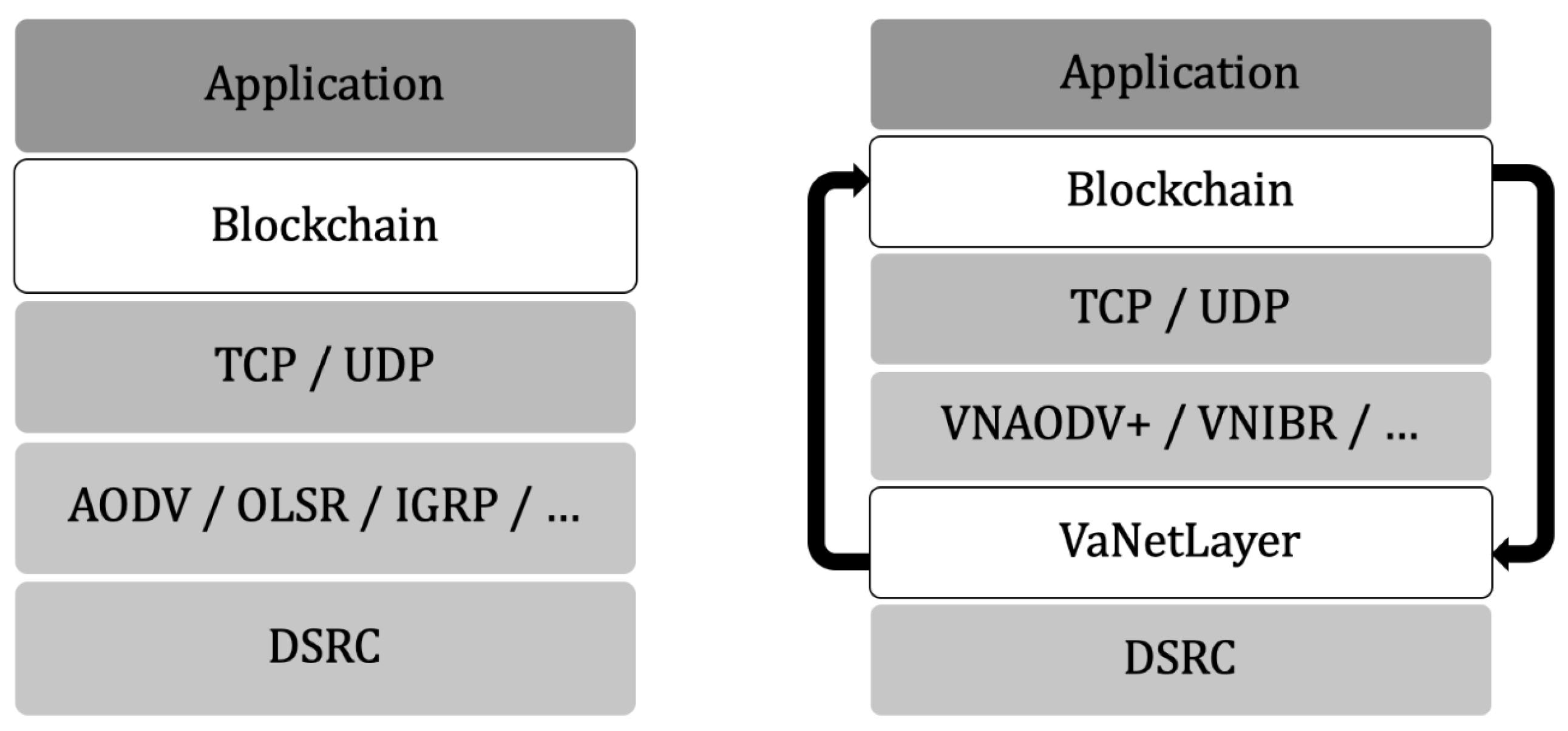
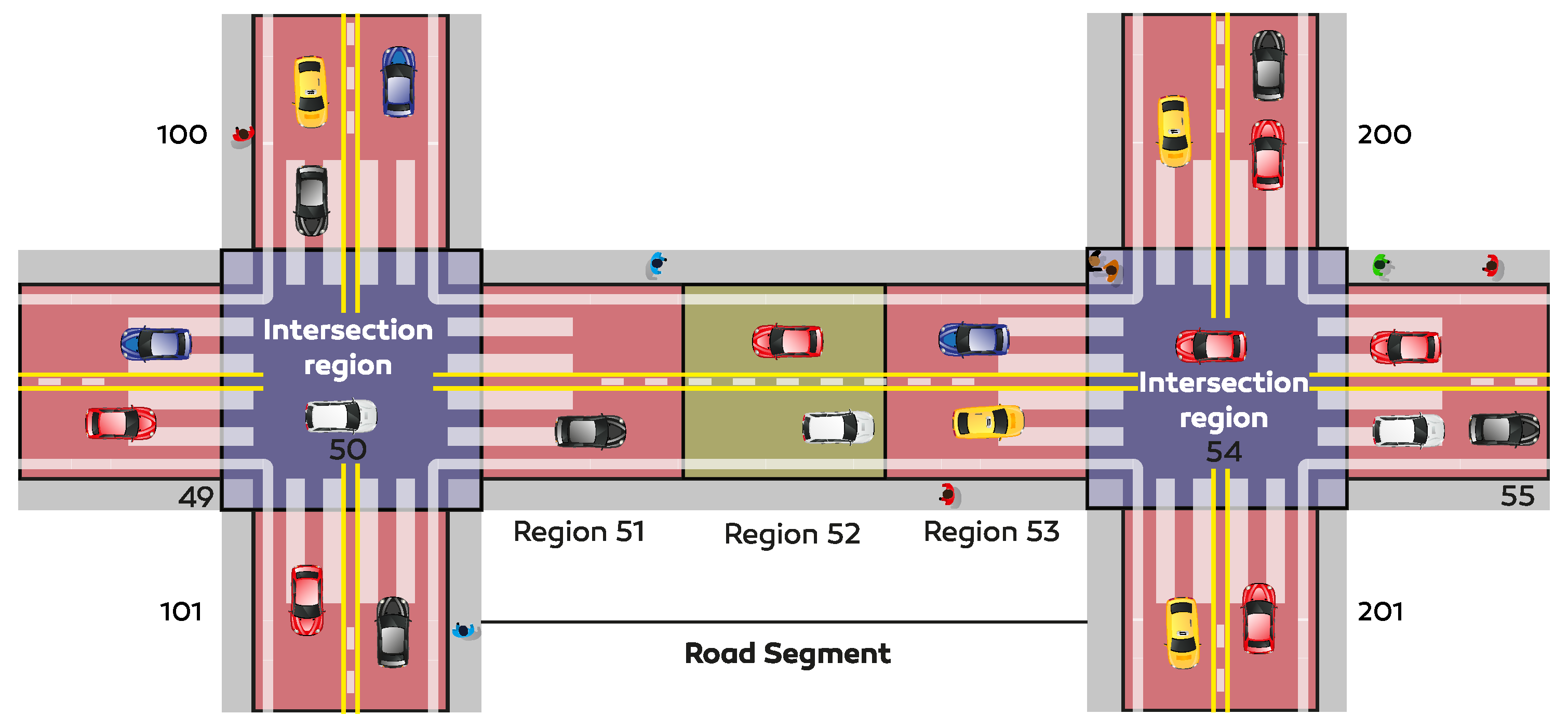
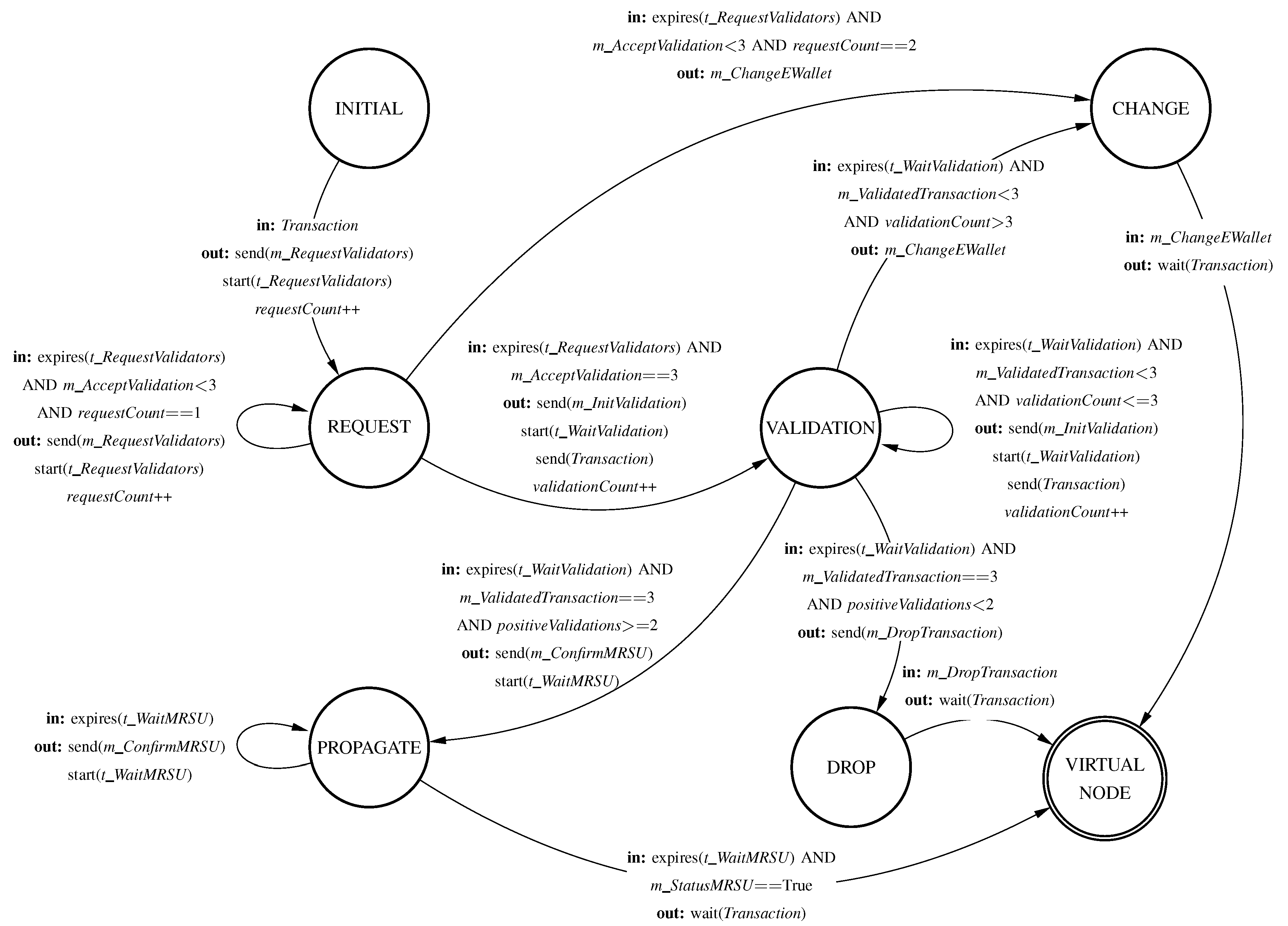
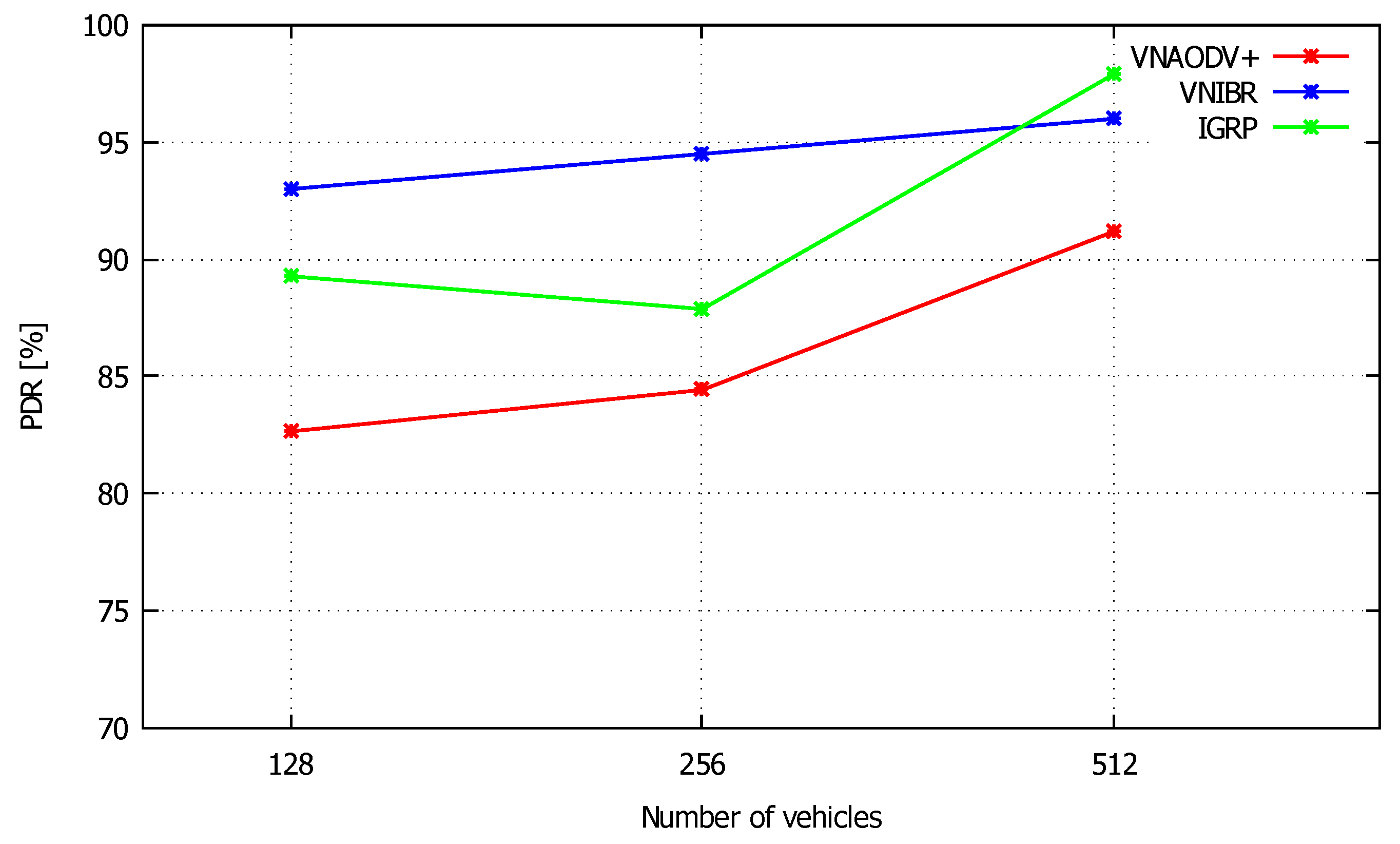
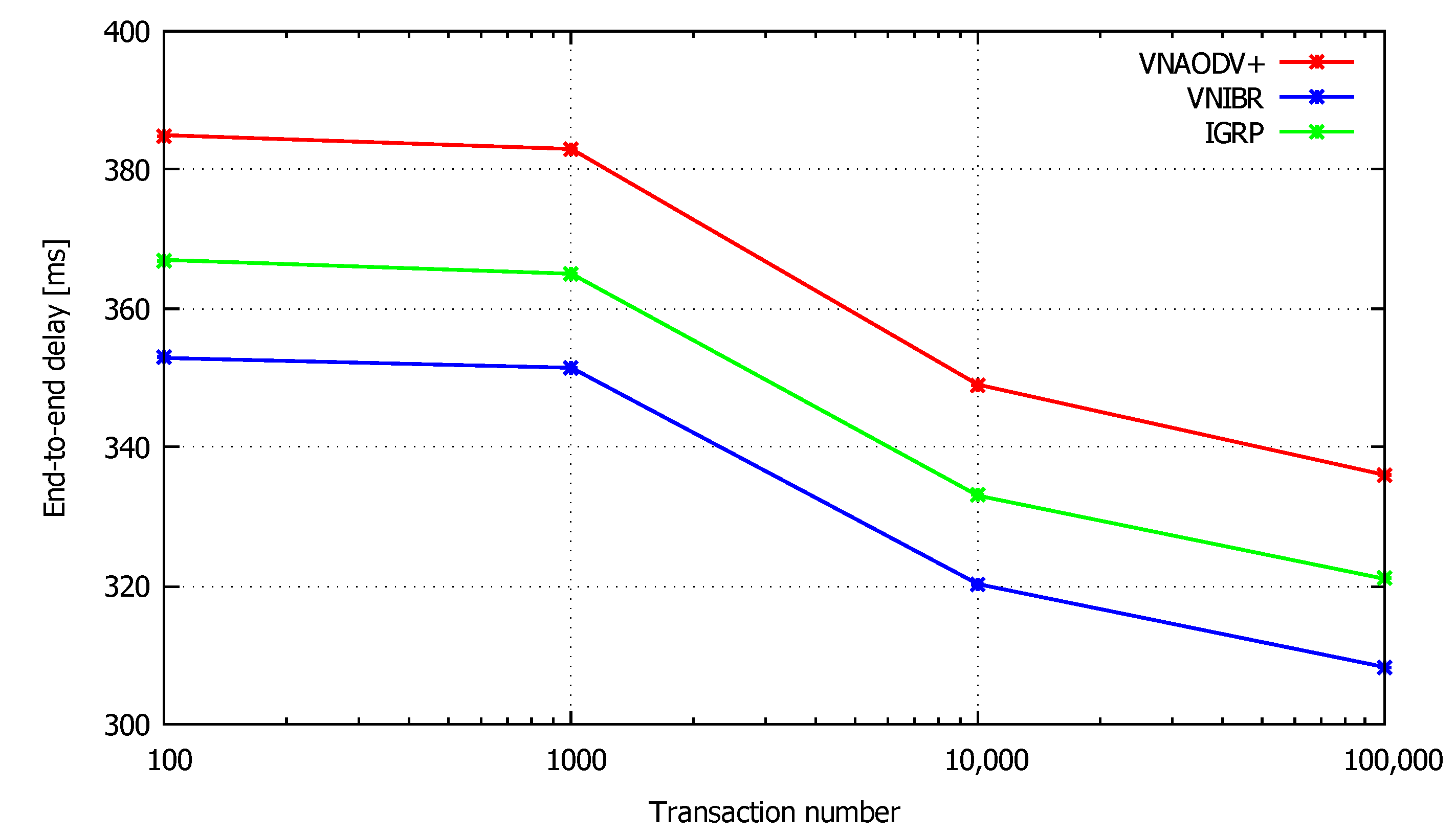
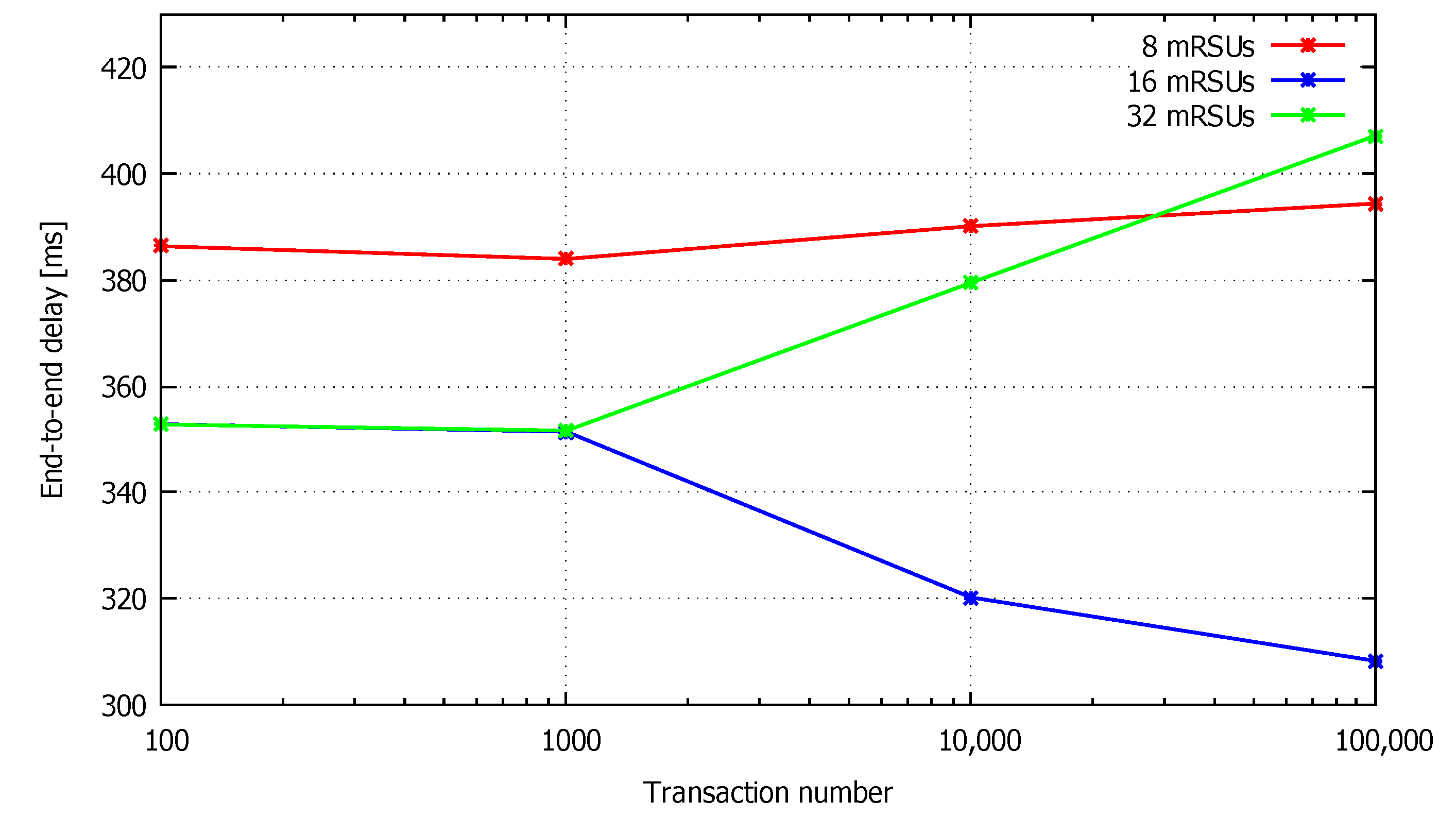
| Parameter | Value |
|---|---|
| Simulator | ns-3, SimBlock |
| Blockchain framework | Ethereum |
| Consensus algorithm | Proof of Work |
| Routing protocol | VNIBR-VNAODV+-IGRP |
| Simulation scenario | Manhattan type urban area |
| Propagation model | Hybrid buildings propagation loss model |
| Intersections number | 64 |
| Intersections separation | 100 m |
| Number of PNs (vehicular density) | 128-256-512 |
| Number of VNs | 421 |
| mRSUs number | 8-16-32 |
| VaNetChain transactions | 100-1000-10,000-100,000 |
| VaNetChain packet size | 1 MB |
| Transmission rate | 6 Mbps |
| MAC | IEEE 802.11p |
| Transport protocol | UDP |
| Smart Contract | Gas Used | Actual Cost [Ether] | USD |
|---|---|---|---|
| Whitelist | 70254 | 0.000140508 | 0.056 |
| Blacklist | 77100 | 0.0001542 | 0.061 |
| Announcement | 34041 | 0.000068082 | 0.027 |
| Verification | 94375 | 0.00018875 | 0.075 |
| Acceptance | 95863 | 0.000191726 | 0.076 |
| Valuation | 164100 | 0.0003282 | 0.13 |
Publisher’s Note: MDPI stays neutral with regard to jurisdictional claims in published maps and institutional affiliations. |
© 2020 by the authors. Licensee MDPI, Basel, Switzerland. This article is an open access article distributed under the terms and conditions of the Creative Commons Attribution (CC BY) license (http://creativecommons.org/licenses/by/4.0/).
Share and Cite
Vintimilla-Tapia, P.; Bravo-Torres, J.; López-Nores, M.; Gallegos-Segovia, P.; Ordóñez-Morales, E.; Ramos-Cabrer, M. VaNetChain: A Framework for Trustworthy Exchanges of Information in VANETs Based on Blockchain and a Virtualization Layer. Appl. Sci. 2020, 10, 7930. https://doi.org/10.3390/app10217930
Vintimilla-Tapia P, Bravo-Torres J, López-Nores M, Gallegos-Segovia P, Ordóñez-Morales E, Ramos-Cabrer M. VaNetChain: A Framework for Trustworthy Exchanges of Information in VANETs Based on Blockchain and a Virtualization Layer. Applied Sciences. 2020; 10(21):7930. https://doi.org/10.3390/app10217930
Chicago/Turabian StyleVintimilla-Tapia, Paúl, Jack Bravo-Torres, Martín López-Nores, Pablo Gallegos-Segovia, Esteban Ordóñez-Morales, and Manuel Ramos-Cabrer. 2020. "VaNetChain: A Framework for Trustworthy Exchanges of Information in VANETs Based on Blockchain and a Virtualization Layer" Applied Sciences 10, no. 21: 7930. https://doi.org/10.3390/app10217930
APA StyleVintimilla-Tapia, P., Bravo-Torres, J., López-Nores, M., Gallegos-Segovia, P., Ordóñez-Morales, E., & Ramos-Cabrer, M. (2020). VaNetChain: A Framework for Trustworthy Exchanges of Information in VANETs Based on Blockchain and a Virtualization Layer. Applied Sciences, 10(21), 7930. https://doi.org/10.3390/app10217930







